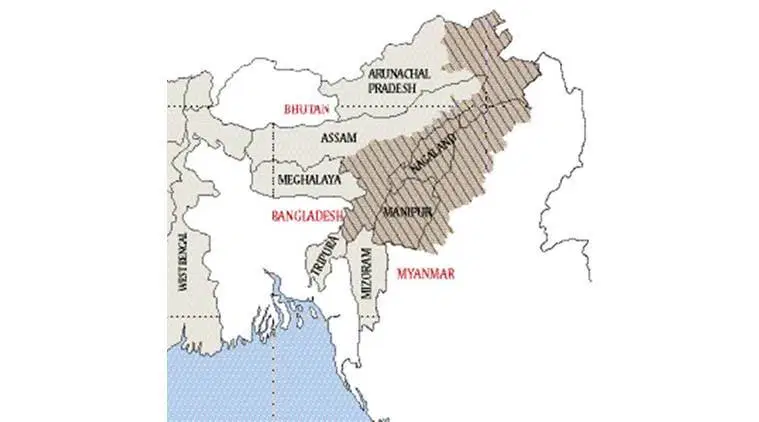NAGA Conundrum | 29 Oct 2019
This article is based on “Naga talks: long road, issues” which was published in The Indian Express on 28/10/2019. It talks about the long history of the Naga issue and various initiatives taken to resolve it.
The Centre’s interlocutor R N Ravi stressed on the need to resolve key issues with the Nationalist Socialist Council of Nagalim (Isak-Muivah) or NSCN-IM as the Centre approaches toward wrapping Naga peace talk till October 31st deadline.
What is Naga Issue?
- The key demand of Naga groups has been a Greater Nagalim (sovereign statehood) i.e redrawing of boundaries to bring all Naga-inhabited areas in the Northeast under one administrative umbrella.
- It includes various parts of Arunachal Pradesh, Manipur, Assam and Myanmar as well.
- The demand also includes the separate Naga Yezabo (Constitution) and Naga national flag.
About Nagas
- The Nagas are not a single tribe, but an ethnic community that comprises several tribes who live in the state of Nagaland and its neighbourhood.
- Nagas belong to Indo-Mongoloid Family.
- Nagas claimed sovereignty on the basis of prior sovereign existence and differences, which is today expressed in terms of “uniqueness”.
- There are nineteen major Naga tribes, namely, Aos, Angamis, Changs, Chakesang, Kabuis, Kacharis, Khain-Mangas, Konyaks, Kukis, Lothas (Lothas), Maos, Mikirs, Phoms, Rengmas, Sangtams, Semas, Tankhuls, Yamchumgar and Zeeliang.
History of Nagas
- The origin of Nagas cannot be traced, but the assertion of Naga nationalism began during British rule, has continued after Independence, and even after Nagaland became a state. Along the way, the unresolved issues gave rise to decades of insurgency that claimed thousands of lives, including that of civilians.
- The British had annexed Assam in 1826, in which they subsequently created the Naga Hills district. The earliest sign of Naga resistance dates back to 1918, with the formation of the Naga Club.
- In 1929, the Naga Club famously told the Simon Commission “to leave us alone to determine for ourselves as in ancient times”.
- In 1946, A Z Phizo formed the Naga National Council (NNC), which declared Naga independence on August 14, 1947, and then, in 1951, claimed to have conducted a referendum in which an overwhelming majority supported an independent Naga state.
- In the 1950s, the NNC took up arms and resorted to violence over Naga’s sovereignty.
- In the year 1975, the NNC split into NSCN, which further split into NSCN (I-M) and NSCN (Khaplang) in 1988.
Peace Initiatives
- Shillong Accord (1975): A peace accord was signed in Shillong in which the NNC leadership agreed to give up arms.
- However, several leaders refused to accept the agreement, which led to the split of NNC.
- Ceasefire Agreement (1997): The NSCN-IM signed a ceasefire agreement with the government to stop attacks on Indian armed forces. In return, the government would stop all counter-insurgency offensive operations.
- Framework Agreement (2015): In this agreement, the Government of India recognised the unique history, culture and position of the Nagas and their sentiments and aspirations.
- The NSCN also appreciated the Indian political system and governance. However, the details of the agreement are yet to be released by the government.
- Recently, the State government decided to prepare the Register of Indigenous Inhabitants of Nagaland but later due to pressure from various fractions, the decision was put on hold.
Stands of other States
The governments and civil society organisations in Arunachal Pradesh, Assam and Manipur have made it clear that they would not compromise on their territorial integrity.
- Recently, Arunachal Pradesh has echoed Manipur in its demand for keeping it out of any territorial changes that might be incorporated in the settlement of the Naga political problem.
What can be done to resolve the issue?
The history of Indo-Naga conflict shows that various past agreements have broken down due to different interpretations of the provisions by the parties at their convenience. Therefore various recommendations described below can help to achieve long-lasting peace in the region.
- Providing autonomous Naga territorial councils for Arunachal and Manipur.
- Common cultural body for Nagas across states.
- Specific institutions for state’s development, integration and rehabilitation of non-state Naga militia.
- Removal of the Armed Forces Special Powers Act.
- A special status on the lines of Article 371-A will be explored for Naga areas outside Nagaland.
- A constitutional body to look into issues related to Nagas in their whole territorial spread.
Conclusion
Nagas are culturally heterogeneous groups of different communities/tribes having a different set of problems from mainstream population. In order to achieve the long-lasting solution, their cultural, historical and territorial extent must be taken into consideration. Therefore any arrangement to be worked out should lead to social and political harmony, economic prosperity and protection of the life and property of all tribes and citizens of the states.
| Drishti Input: Briefly explain the Naga crisis, along with initiatives taken to resolve the issues. |

